Abstract
Stimulation of Na+/H+ exchange by growth factors has been implicated as a mechanism allowing quiescent cells to resume growth because of a predicted elevation of intracellular pH(pHi). We tested this prediction in NR6 cells by using a further development of our technique for pHi measurement, based on introduction of the fluorescent pH indicator 4',5'-dimethylfluorescein (pKa = 6.75) coupled to dextran into the cytoplasm. Addition of the potent mitogens platelet-derived growth factor (PDGF) or serum to NR6 cells stimulates an amiloride-sensitive 22Na+ uptake and causes an elevation of pHi. The PDGF-dependent pHi increase follows a lag period of approximately equal to 2 min, reaches a maximal level within 10 min (delta pHi approximately equal to 0.1 at an external pH of 7.18), and remains at this level for at least 1 hr. Serum addition initially produces a large elevation of pHi, which later declines to a level similar to that obtained with PDGF. The effects of PDGF and serum are partially additive (delta pHi approximately equal to 0.14). The magnitude of pHi elevation by PDGF decreases with increasing extracellular pH. Serum- and PDGF-dependent elevations of pHi are inhibited by amiloride and by eliminating Na+ from the medium. Under conditions in which Na+/H+ exchange is inhibited, PDGF and serum induce an initial cytoplasmic acidification that does not show a lag period. The results show that a single purified growth factor, as well as serum, can promote a sustained elevation of pHi by stimulating Na+/H+ exchange. The extent of pHi elevation may be modulated by the concomitant stimulation by the growth factor of a process generating H+ within the cell.
Full text
PDF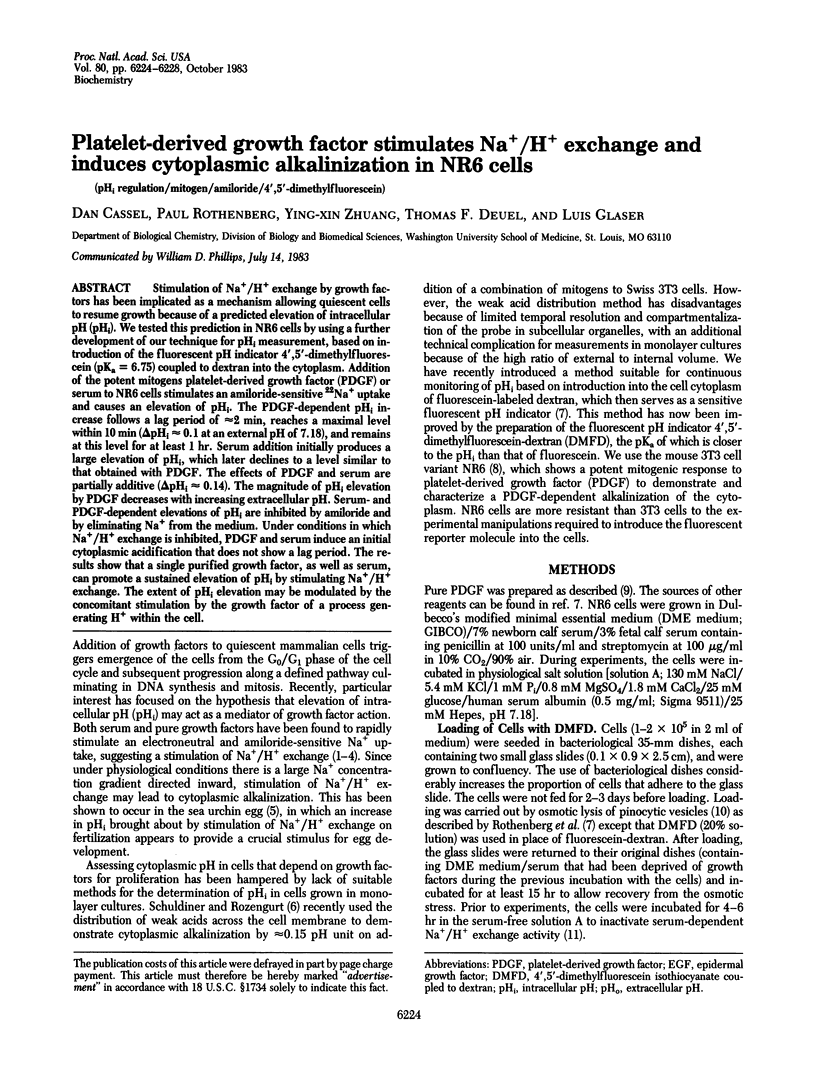
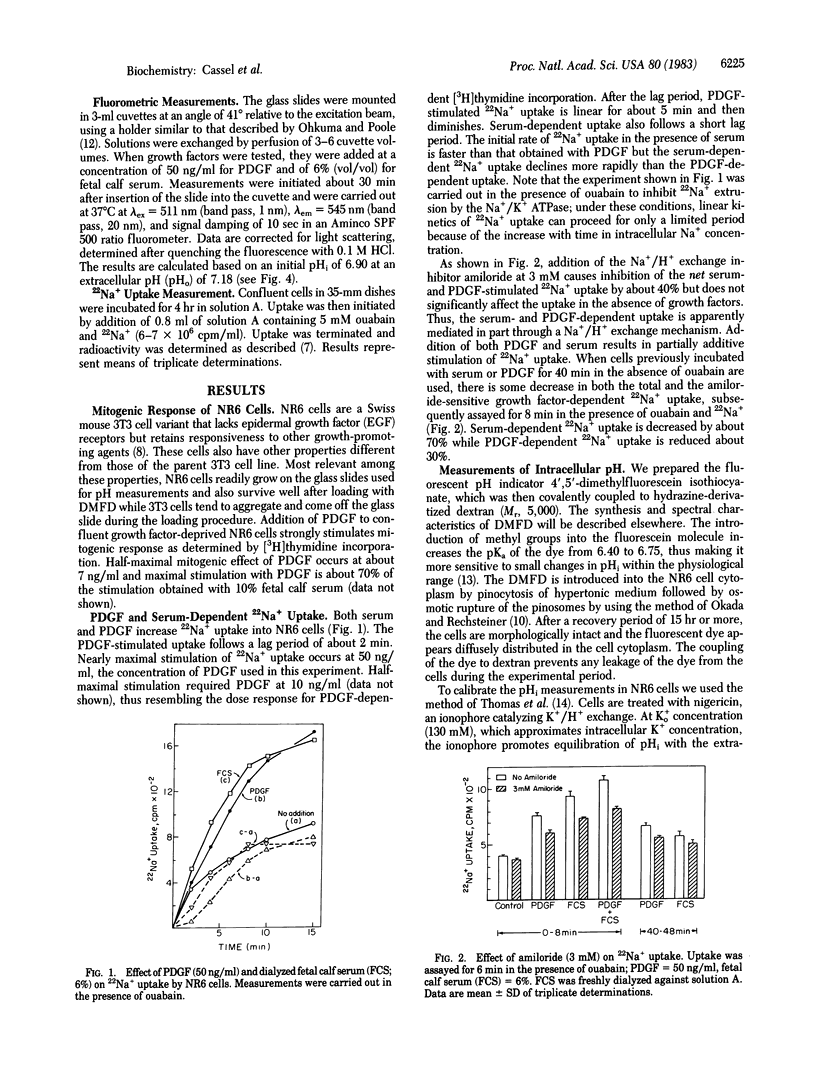
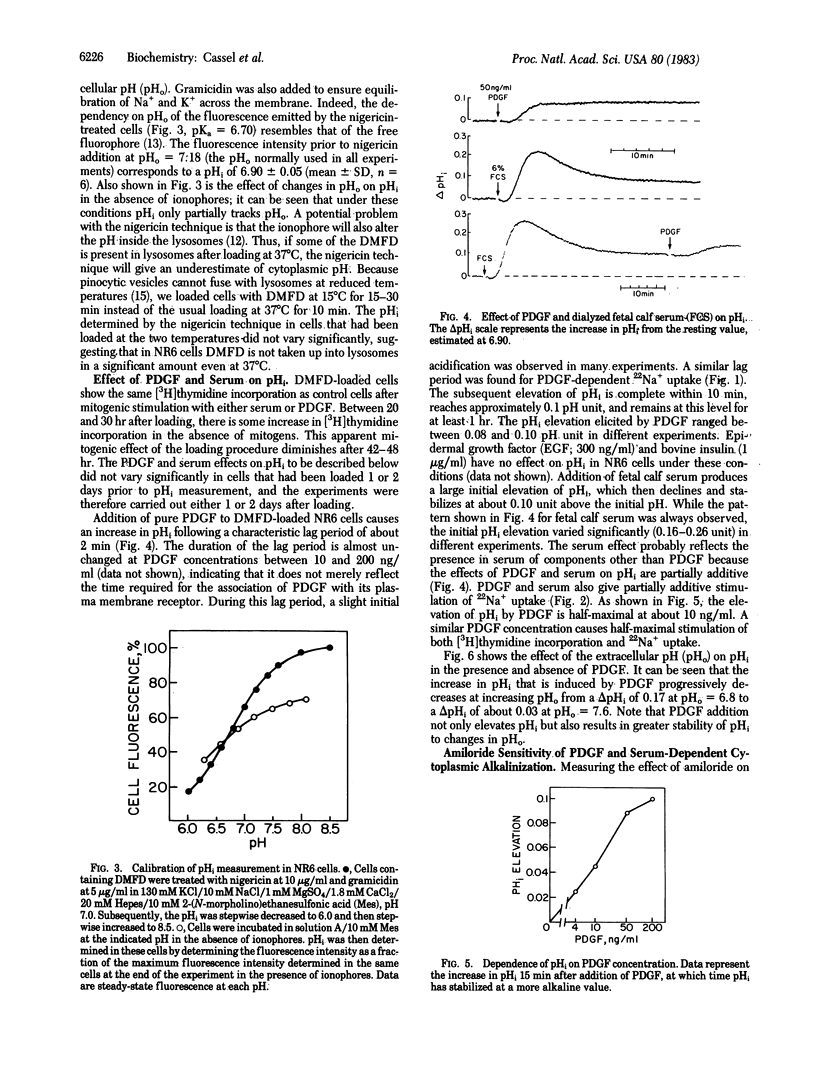
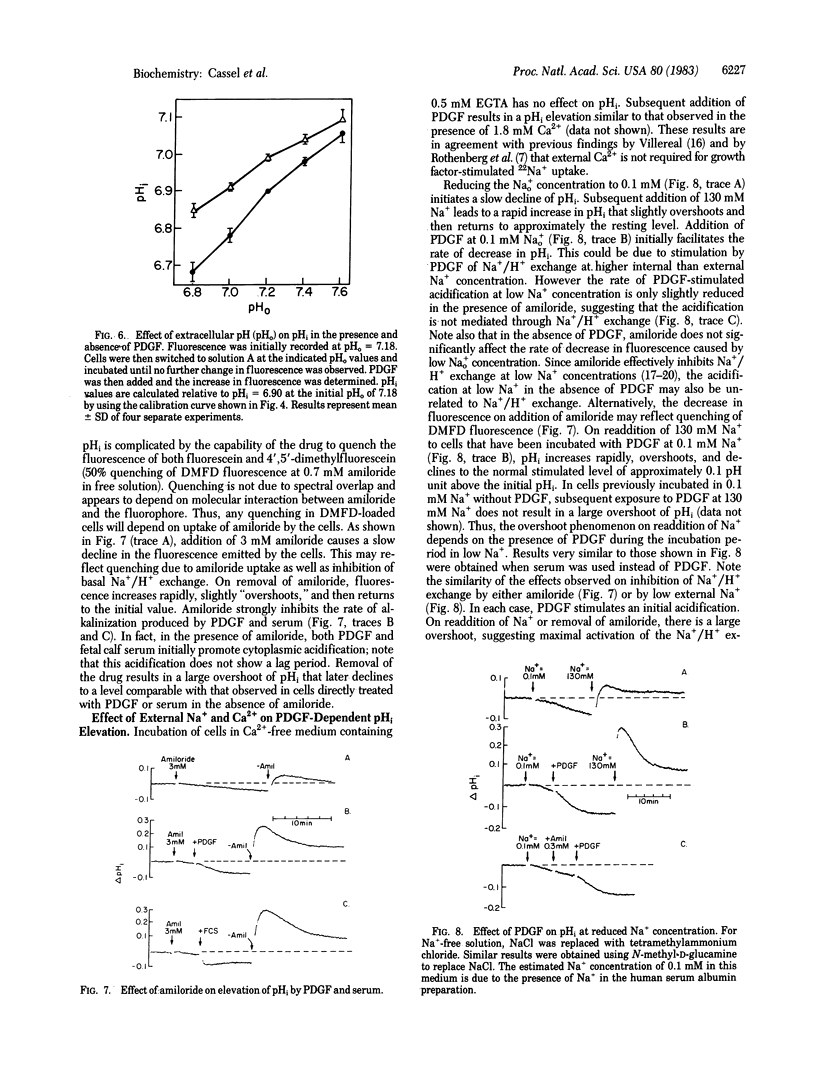
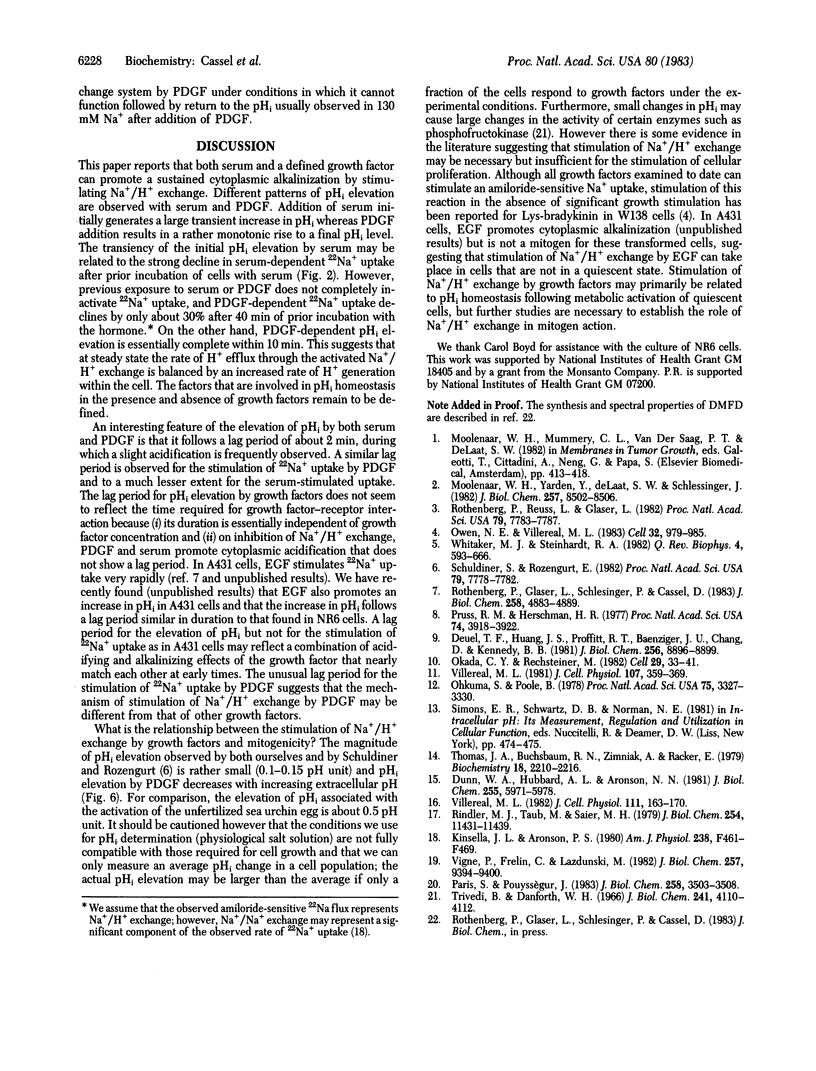
Selected References
These references are in PubMed. This may not be the complete list of references from this article.
- Deuel T. F., Huang J. S., Proffitt R. T., Baenziger J. U., Chang D., Kennedy B. B. Human platelet-derived growth factor. Purification and resolution into two active protein fractions. J Biol Chem. 1981 Sep 10;256(17):8896–8899. [PubMed] [Google Scholar]
- Dunn W. A., Hubbard A. L., Aronson N. N., Jr Low temperature selectively inhibits fusion between pinocytic vesicles and lysosomes during heterophagy of 125I-asialofetuin by the perfused rat liver. J Biol Chem. 1980 Jun 25;255(12):5971–5978. [PubMed] [Google Scholar]
- Kinsella J. L., Aronson P. S. Properties of the Na+-H+ exchanger in renal microvillus membrane vesicles. Am J Physiol. 1980 Jun;238(6):F461–F469. doi: 10.1152/ajprenal.1980.238.6.F461. [DOI] [PubMed] [Google Scholar]
- Moolenaar W. H., Yarden Y., de Laat S. W., Schlessinger J. Epidermal growth factor induces electrically silent Na+ influx in human fibroblasts. J Biol Chem. 1982 Jul 25;257(14):8502–8506. [PubMed] [Google Scholar]
- Ohkuma S., Poole B. Fluorescence probe measurement of the intralysosomal pH in living cells and the perturbation of pH by various agents. Proc Natl Acad Sci U S A. 1978 Jul;75(7):3327–3331. doi: 10.1073/pnas.75.7.3327. [DOI] [PMC free article] [PubMed] [Google Scholar]
- Okada C. Y., Rechsteiner M. Introduction of macromolecules into cultured mammalian cells by osmotic lysis of pinocytic vesicles. Cell. 1982 May;29(1):33–41. doi: 10.1016/0092-8674(82)90087-3. [DOI] [PubMed] [Google Scholar]
- Owen N. E., Villereal M. L. Lys-bradykinin stimulates Na+ influx and DNA synthesis in cultured human fibroblasts. Cell. 1983 Mar;32(3):979–985. doi: 10.1016/0092-8674(83)90082-x. [DOI] [PubMed] [Google Scholar]
- Paris S., Pouysségur J. Biochemical characterization of the amiloride-sensitive Na+/H+ antiport in Chinese hamster lung fibroblasts. J Biol Chem. 1983 Mar 25;258(6):3503–3508. [PubMed] [Google Scholar]
- Pruss R. M., Herschman H. R. Variants of 3T3 cells lacking mitogenic response to epidermal growth factor. Proc Natl Acad Sci U S A. 1977 Sep;74(9):3918–3921. doi: 10.1073/pnas.74.9.3918. [DOI] [PMC free article] [PubMed] [Google Scholar]
- Rindler M. J., Taub M., Saier M. H., Jr Uptake of 22Na+ by cultured dog kidney cells (MDCK). J Biol Chem. 1979 Nov 25;254(22):11431–11439. [PubMed] [Google Scholar]
- Rothenberg P., Glaser L., Schlesinger P., Cassel D. Epidermal growth factor stimulates amiloride-sensitive 22Na+ uptake in A431 cells. Evidence for Na+/H+ exchange. J Biol Chem. 1983 Apr 25;258(8):4883–4889. [PubMed] [Google Scholar]
- Rothenberg P., Reuss L., Glaser L. Serum and epidermal growth factor transiently depolarize quiescent BSC-1 epithelial cells. Proc Natl Acad Sci U S A. 1982 Dec;79(24):7783–7787. doi: 10.1073/pnas.79.24.7783. [DOI] [PMC free article] [PubMed] [Google Scholar]
- Schuldiner S., Rozengurt E. Na+/H+ antiport in Swiss 3T3 cells: mitogenic stimulation leads to cytoplasmic alkalinization. Proc Natl Acad Sci U S A. 1982 Dec;79(24):7778–7782. doi: 10.1073/pnas.79.24.7778. [DOI] [PMC free article] [PubMed] [Google Scholar]
- Thomas J. A., Buchsbaum R. N., Zimniak A., Racker E. Intracellular pH measurements in Ehrlich ascites tumor cells utilizing spectroscopic probes generated in situ. Biochemistry. 1979 May 29;18(11):2210–2218. doi: 10.1021/bi00578a012. [DOI] [PubMed] [Google Scholar]
- Trivedi B., Danforth W. H. Effect of pH on the kinetics of frog muscle phosphofructokinase. J Biol Chem. 1966 Sep 10;241(17):4110–4112. [PubMed] [Google Scholar]
- Vigne P., Frelin C., Lazdunski M. The amiloride-sensitive Na+/H+ exchange system in skeletal muscle cells in culture. J Biol Chem. 1982 Aug 25;257(16):9394–9400. [PubMed] [Google Scholar]
- Villereal M. L. Inhibition of the serum-dependent, amiloride-sensitive sodium transport pathway in human fibroblasts by extracellular divalent cations. J Cell Physiol. 1982 May;111(2):163–170. doi: 10.1002/jcp.1041110207. [DOI] [PubMed] [Google Scholar]
- Villereal M. L. Sodium fluxes in human fibroblasts: effect of serum, Ca+2, and amiloride. J Cell Physiol. 1981 Jun;107(3):359–369. doi: 10.1002/jcp.1041070307. [DOI] [PubMed] [Google Scholar]
- Whitaker M. J., Steinhardt R. A. Ionic regulation of egg activation. Q Rev Biophys. 1982 Nov;15(4):593–666. doi: 10.1017/s0033583500003760. [DOI] [PubMed] [Google Scholar]


